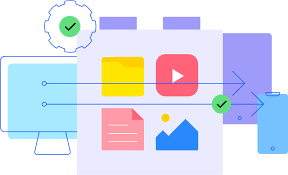Hello!
 The future of content creation and data management is low code integration. Low code software platforms allow anyone with an idea to bring that idea to life as a robust, full-featured website or app in a visual, intuitive way.
The future of content creation and data management is low code integration. Low code software platforms allow anyone with an idea to bring that idea to life as a robust, full-featured website or app in a visual, intuitive way.
Best of all, this can occur without the need for advanced coding know-how.
Just like a low code integration platform for website design can revolutionize the process of creating a brand or an eCommerce enterprise, low code data integration and low code ETL (extract, transform, load) platforms can overhaul your operation.
Streamline the way you harvest, interpret, and use mission-critical data. Plus, you won’t need to learn a clunky database query system or arcane back-end coding skills.
Here are five benefits of low code integration:
1. Improve Your Bottom Line
 Pivoting to a fully customized low code integration platform that will handle your data ETL processes might sound like a significant investment — not just financially, but in terms of committing to new technology.
Pivoting to a fully customized low code integration platform that will handle your data ETL processes might sound like a significant investment — not just financially, but in terms of committing to new technology.
While there is some truth to that, building a low code ETL framework can save your organization time and money in the long run.
You will be making a new technology part of your business processes, but you will also soon realize that the nature of low code projects means you and your staff will spend less time than ever before grinding through obscure database queries or data conversion processes.
Setting up a fully customized low code ETL solution to streamline your data can involve a lot of time and testing, just like any other major IT or development undertaking. Consider the alternatives of hiring in-house developers and analysts or contracting with expensive third-party data consultants. The average salary for a software developer in the United States is nearly $100,000. Hiring dedicated developers to perform work that could primarily be handled by an intelligent, streamlined low code ETL platform wastes time, talent, and capital.
2. Rapid Response to Challenges
 Low code ETL integration that streams and interprets data almost in real-time can detect anomalies and react to changes in conditions faster than even a dedicated team of human analysts.
Low code ETL integration that streams and interprets data almost in real-time can detect anomalies and react to changes in conditions faster than even a dedicated team of human analysts.
Low code ETL will help you and your staff respond to changing markets, overcome technological hiccups, streamline supply chains in an uncertain economy, and nail the day-to-day challenges of running a successful, data-driven operation.
With low code ETL platform integration, you get to focus on understanding and leveraging your data. You won’t need to waste time on the technical aspects of locating, extracting, moving, and parsing it.
3. Expedited Project Timelines
Low code ETL is not just crucial for quickly responding to emergent crises. It also improves timelines (and budgets) for all of your routine data-dependent projects.
Industry data shows that around half of all IT projects are completed behind schedule. Even firms that invest in professional project management only complete their projects by the deadline around 60% of the time. These failures persist despite the ever-increasing pressure for modern, technology-dependent businesses to be responsive, scalable, and stable.
 Low code ETL platforms help drive projects to satisfactory and timely outcomes by intuitively providing your operation with a stream of relevant, actionable data without the need for constant hands-on intervention from tech support staff and programmers.
Low code ETL platforms help drive projects to satisfactory and timely outcomes by intuitively providing your operation with a stream of relevant, actionable data without the need for constant hands-on intervention from tech support staff and programmers.
A streamlined data plumbing and ETL process can also positively affect all tech timelines across your entire company by simply reducing the burden on staff.
An effectively automated ETL framework can free up staff who might otherwise be wrangling records out of massive data files or writing database queries by hand.
4. Cross-Compatibility
The ETL framework allows you to transport and translate data across various sources and systems. With a low code philosophy driving the development of this framework, the process of getting data from point A to point B becomes even more intuitive.
 Traditionally, things like legacy systems, products from different vendors, work sites using different software versions, customers using unfamiliar systems, uncommon file formats, and data warehouses with peculiar record specifications have represented major headaches for tech staff trying to efficiently transport data from one part of an organization to another. A robust low code ETL program built to your company’s needs can transform these transitions from frustrating and tedious to seamless and invisible.
Traditionally, things like legacy systems, products from different vendors, work sites using different software versions, customers using unfamiliar systems, uncommon file formats, and data warehouses with peculiar record specifications have represented major headaches for tech staff trying to efficiently transport data from one part of an organization to another. A robust low code ETL program built to your company’s needs can transform these transitions from frustrating and tedious to seamless and invisible.
Nontypical data sets, mismatched record formats, incompatible file types, and nonconforming data sources of all imaginable types become irrelevant when you build an intelligent, adaptive data pipeline built to meet your operation’s exact needs. Compatibility across your data sources and data warehouses can be managed seamlessly by your technology instead of painstakingly tackled by your tech staff.
A custom-built ETL framework can help you clean up your data processes and eliminate your reliance on legacy systems. An organization that works with large amounts of data can easily get bogged down by old software and outdated systems. The organization may be hesitant to upgrade simply due to the amount of data and old business stored in those legacy systems. A robust, intelligent low code ETL framework can help you simplify and expedite even the largest and most complex data migrations so you can leave outdated technologies in the past.
5. Increased Collaboration
 The primary driving principle behind low code systems is that anyone with a good idea should be able to act on that idea without needing to possess a high degree of specialized technical knowledge. In short, a successful low code ETL framework will make your data more accessible and actionable than ever before for your employees and other stakeholders. This openness and expanded access naturally promote collaboration among your various employees, departments, and teams.
The primary driving principle behind low code systems is that anyone with a good idea should be able to act on that idea without needing to possess a high degree of specialized technical knowledge. In short, a successful low code ETL framework will make your data more accessible and actionable than ever before for your employees and other stakeholders. This openness and expanded access naturally promote collaboration among your various employees, departments, and teams.
Which data is more valuable to your company: data that is gate-kept by a highly specialized IT staff trained in particular database technology, or data that all your employees are empowered to use and understand?
Rather than every department trying to explain what they want to a development team, and the development team, in turn, trying to parse this into effective code, the entire company can work with a shared visual language.
This is a core aspect of how low code software systems work. It’s also part of what makes these systems modular, adaptable, and accessible.
The nature of low code ETL frameworks also allows multiple users to work with the same data at the same time. Modern professionals are used to seamless, real-time collaboration due to technologies like screen sharing and Google Docs. However, a low code data platform that is intelligently designed and successfully deployed allows you to extend those collaborative principles to your data management and development activities.
Also read:
- What are The Most Secure Environments for App Development?
- CAPTCHAs Don’t Work: Anti-Spam Honeypot
- What Can I Do With a Degree in English?
Thank you!
Join us on social networks!
See you!






